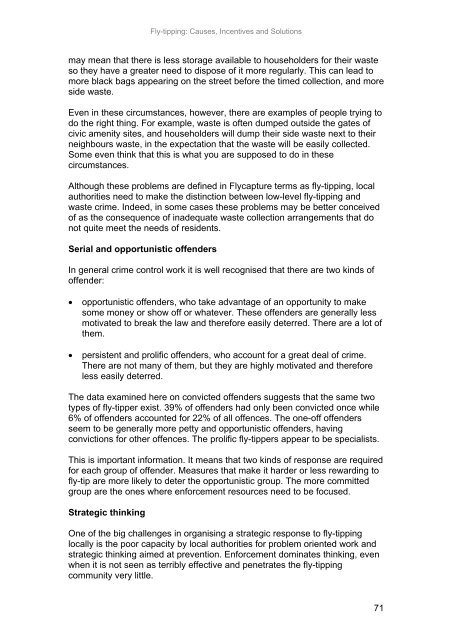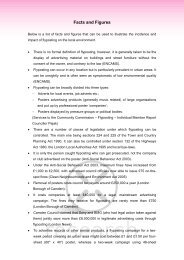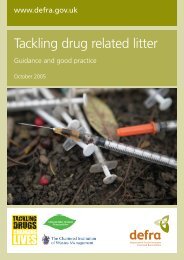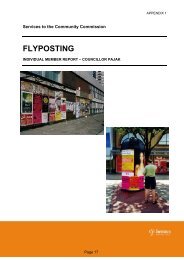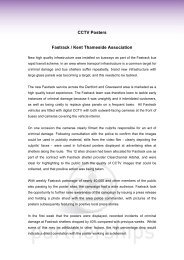Fly-tipping: Causes, Incentives and Solutions - Keep Britain Tidy
Fly-tipping: Causes, Incentives and Solutions - Keep Britain Tidy
Fly-tipping: Causes, Incentives and Solutions - Keep Britain Tidy
Create successful ePaper yourself
Turn your PDF publications into a flip-book with our unique Google optimized e-Paper software.
<strong>Fly</strong>-<strong>tipping</strong>: <strong>Causes</strong>, <strong>Incentives</strong> <strong>and</strong> <strong>Solutions</strong><br />
may mean that there is less storage available to householders for their waste<br />
so they have a greater need to dispose of it more regularly. This can lead to<br />
more black bags appearing on the street before the timed collection, <strong>and</strong> more<br />
side waste.<br />
Even in these circumstances, however, there are examples of people trying to<br />
do the right thing. For example, waste is often dumped outside the gates of<br />
civic amenity sites, <strong>and</strong> householders will dump their side waste next to their<br />
neighbours waste, in the expectation that the waste will be easily collected.<br />
Some even think that this is what you are supposed to do in these<br />
circumstances.<br />
Although these problems are defined in <strong>Fly</strong>capture terms as fly-<strong>tipping</strong>, local<br />
authorities need to make the distinction between low-level fly-<strong>tipping</strong> <strong>and</strong><br />
waste crime. Indeed, in some cases these problems may be better conceived<br />
of as the consequence of inadequate waste collection arrangements that do<br />
not quite meet the needs of residents.<br />
Serial <strong>and</strong> opportunistic offenders<br />
In general crime control work it is well recognised that there are two kinds of<br />
offender:<br />
• opportunistic offenders, who take advantage of an opportunity to make<br />
some money or show off or whatever. These offenders are generally less<br />
motivated to break the law <strong>and</strong> therefore easily deterred. There are a lot of<br />
them.<br />
• persistent <strong>and</strong> prolific offenders, who account for a great deal of crime.<br />
There are not many of them, but they are highly motivated <strong>and</strong> therefore<br />
less easily deterred.<br />
The data examined here on convicted offenders suggests that the same two<br />
types of fly-tipper exist. 39% of offenders had only been convicted once while<br />
6% of offenders accounted for 22% of all offences. The one-off offenders<br />
seem to be generally more petty <strong>and</strong> opportunistic offenders, having<br />
convictions for other offences. The prolific fly-tippers appear to be specialists.<br />
This is important information. It means that two kinds of response are required<br />
for each group of offender. Measures that make it harder or less rewarding to<br />
fly-tip are more likely to deter the opportunistic group. The more committed<br />
group are the ones where enforcement resources need to be focused.<br />
Strategic thinking<br />
One of the big challenges in organising a strategic response to fly-<strong>tipping</strong><br />
locally is the poor capacity by local authorities for problem oriented work <strong>and</strong><br />
strategic thinking aimed at prevention. Enforcement dominates thinking, even<br />
when it is not seen as terribly effective <strong>and</strong> penetrates the fly-<strong>tipping</strong><br />
community very little.<br />
71


